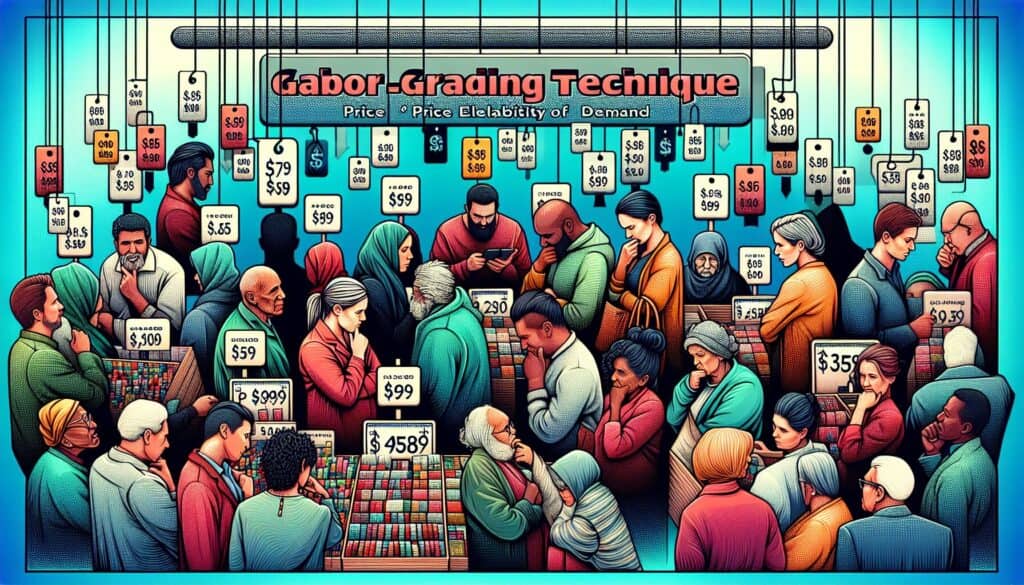Déterminer l'élasticité de la demande d'un produit par rapport au prix en demandant à des clients potentiels s'ils sont susceptibles d'acheter à différents niveaux de prix.
- Méthodologies : Clients et marketing, Idéation, Conception de Produits
Technique de tarification de Gabor-Granger

Technique de tarification de Gabor-Granger
- Expérience client, Étude de marché, Gestion de produits, Prix des produits
Objectif :
Comment il est utilisé :
- On montre un produit aux personnes interrogées et on leur demande si elles l'achèteraient à un prix donné. Dans l'affirmative, le prix est augmenté ; dans la négative, il est baissé (ou une série aléatoire de prix est présentée). Ce processus se poursuit pour plusieurs points de prix afin de créer une courbe de la demande.
Avantages
- Mesure directement la volonté d'acheter à des prix spécifiques, aide à estimer les revenus et le potentiel de profit à différents niveaux de prix, relativement simple à mettre en œuvre dans les enquêtes.
Inconvénients
- L'intention d'achat hypothétique peut ne pas refléter le comportement d'achat réel, elle ne tient pas compte explicitement des actions des concurrents ou des alternatives de produits dans le questionnement.
Catégories :
- Clients et marketing, Économie
Idéal pour :
- Estimation de la demande et des recettes potentielles pour un produit à différents niveaux de prix.
La technique de tarification de Gabor-Granger est particulièrement efficace à différents stades du développement des produits et des stratégies de marketing dans plusieurs secteurs, notamment les biens de consommation, la technologie et les produits pharmaceutiques. Cette méthodologie peut être particulièrement utile pendant les phases d'idéation du produit et de test du prototype, où la compréhension du sentiment des clients à l'égard de la tarification peut permettre de prendre des décisions éclairées en matière de conception et de marketing. Les principaux participants à cette technique sont généralement des chefs de produit, des spécialistes des études de marché et des stratèges en matière de tarification qui, ensemble, analysent les réponses des clients afin d'élaborer des stratégies de tarification qui correspondent à la valeur perçue. Par exemple, dans le secteur technologique, les entreprises qui lancent de nouveaux appareils peuvent utiliser cette méthode pour évaluer comment les clients potentiels réagissent à différents niveaux de prix, ce qui leur permet d'optimiser les stratégies de prix juste avant le lancement. L'industrie de la santé utilise souvent cette technique dans les études de marché pour les nouveaux médicaments ou dispositifs médicaux, où il est essentiel de comprendre la dynamique des prix pour garantir l'accès au marché et le remboursement. La simplicité de cette méthode permet aux organisations de recueillir efficacement des données quantifiables par le biais d'enquêtes et de plateformes en ligne, qui peuvent être rapidement analysées pour générer des courbes de demande, fournissant ainsi des informations exploitables qui peuvent s'adapter à différents segments et préférences. En incorporant des facteurs démographiques ou des profils psychographiques, les entreprises peuvent segmenter les réponses, ce qui permet de mettre en place des stratégies de tarification ciblées qui s'adressent spécifiquement à des bases de consommateurs identifiées, améliorant ainsi le potentiel de revenus tout en affinant les offres de produits sur la base de données réelles du marché. Cette adaptabilité fait de l'approche de Gabor-Granger un outil polyvalent pour les organisations qui doivent faire face aux multiples incertitudes du marché.
Principales étapes de cette méthodologie
- Montrez aux répondants un produit et un prix initial.
- Demandez aux répondants s'ils achèteraient le produit à ce prix.
- Si oui, augmenter le prix lors de la prochaine itération ; si non, diminuer le prix.
- Répétez ce processus pour une série de prix afin de cartographier la demande.
- Analysez les réponses pour construire une courbe de demande basée sur la volonté d'acheter.
Conseils de pro
- Effectuez une analyse de sensibilité pour comprendre comment les variations de prix affectent l'élasticité de la demande, en affinant vos fourchettes de prix en conséquence.
- Incorporez des facteurs psychographiques dans la conception de votre enquête afin de cerner les motivations profondes et les seuils psychologiques de tarification des différents segments.
- Améliorer les expériences de tarification en utilisant des méthodologies de test A/B pour identifier les points de prix les plus efficaces dans des contextes en temps réel.
Lire et comparer plusieurs méthodologies, nous recommandons le
> Référentiel méthodologique étendu <
ainsi que plus de 400 autres méthodologies.
Vos commentaires sur cette méthodologie ou des informations supplémentaires sont les bienvenus sur le site web de la Commission européenne. section des commentaires ci-dessous ↓ , ainsi que toute idée ou lien en rapport avec l'ingénierie.
Contexte historique
1960
1980
1983
1990
1995
2000
2010
1950
1980
1980
1986
1994
1995
2000
(si la date est inconnue ou n'est pas pertinente, par exemple "mécanique des fluides", une estimation arrondie de son émergence notable est fournie)














Articles Similaires
Simulation de Monte Carlo
Tests basés sur des modèles
Contrôle des modèles
Recherche sur les méthodes mixtes
À l'épreuve des erreurs (Poka-Yoke)
Test du profil de la mission